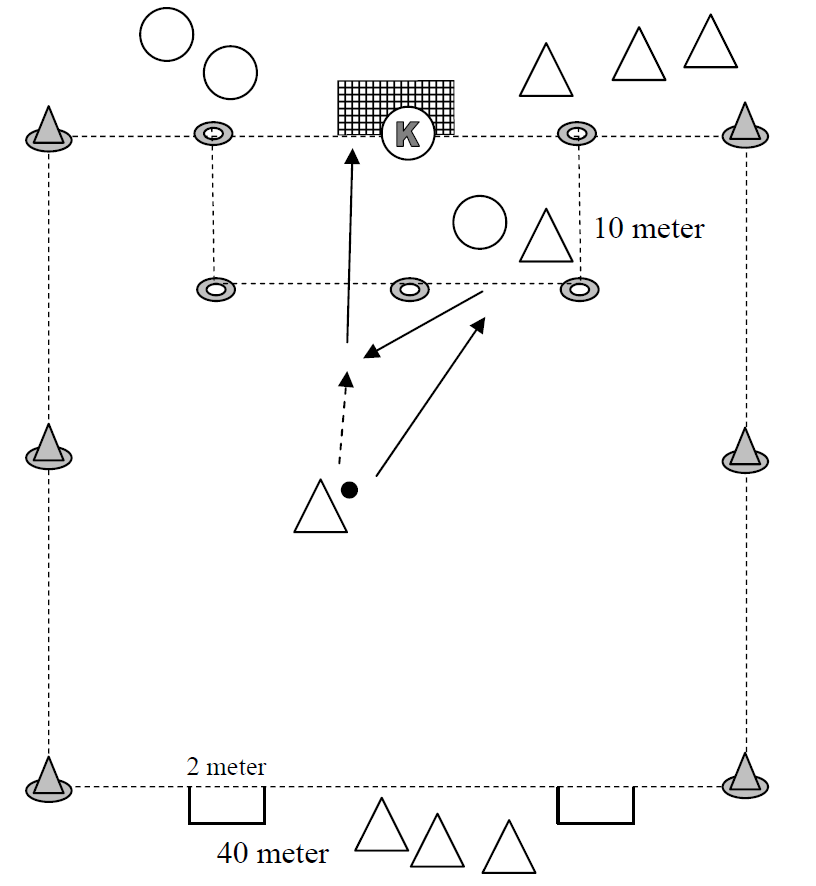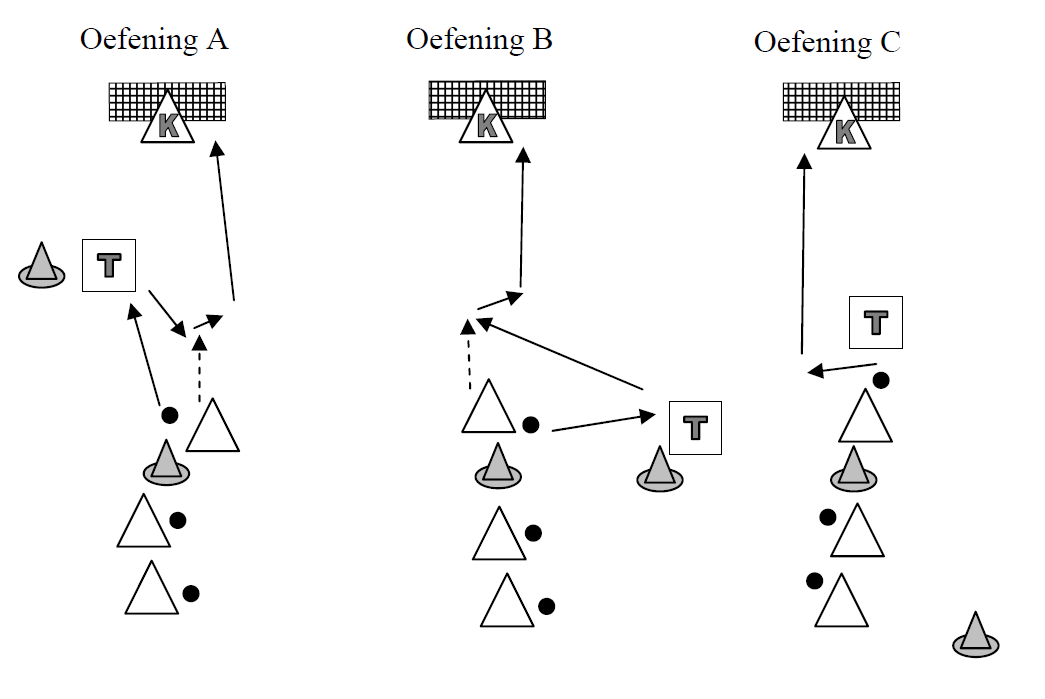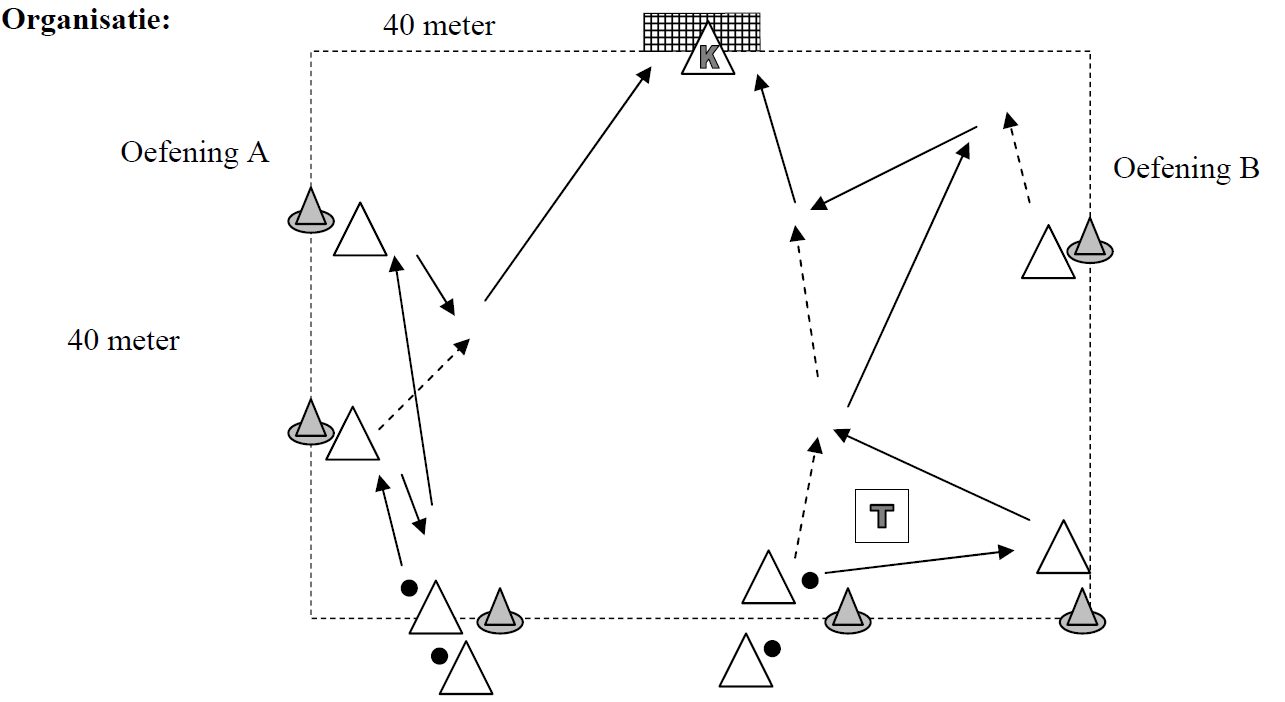Soccer drills

Organisation:
In exercise A the team is divided into two groups, one on the left and one on the right.
A cross is hit from the back line. The incoming attackers cross each other. The player who shot at the goal collects the ball and goes behind. The player who hit the cross becomes the attacker.
In exercise B, the ball is shot on goal after a handball and 1-2 combination. You can do this yourself,
After the exercise has gone well, you can act as defender here.
The players move on.
Points of attention:
Movement towards the ball.
Playing clean and hard.

Organization:
2 attackers against 1 defender + a goalkeeper.
The attacking team can score from outside the 10 meter zone by shooting directly after the handball
. If they enter the 10-meter zone, they can choose how to score.
After a chance, missed or hit, or when the ball goes out to the sides, the ball is exchanged.
The defender can score on the 2 small goals.
Points of attention:
Move to the side to make room for your team-mate.

Organization:
Divide the team into two groups. Everyone has a ball. Each group near a goal with a goalkeeper. There are different ways to finish on goal.
Exercise A is with a handball. The players have to set the ball up with the outside of their foot so that they can shoot at the goal in one fluent movement.
In exercise B the ball is played to them from the side. They receive the ball with their left and shoot with their right. If the pass from the trainer comes from the left, they take the ball with the right and shoot with the left.
In exercise C they come up to the trainer and cut the ball with the inside or the outside of the foot. After the cutting movement they must try to shoot directly.
Points of attention:
Look at their standing leg at the moment they shoot.
Do they estimate the ball speed correctly?

Organization:
Divide the team into 2 groups. Everyone has a ball. Each group near a goal with a goalkeeper.
There are different ways to finish on the goal.
Exercise A is with a handball.
In exercise B the ball is played to them from the side.
In exercise C the ball comes from behind.
If everything goes well, you can also try other variations.
For example: throwing up the ball; throwing the ball over a player who has his back to the goal.
Some remarks:
With F-pupils it is recommended to play handball yourself. This is to keep the pace of the exercise
.
In the second year of E-pupils, you can also let them pass.
Points of attention
Look at their standing leg at the moment of
shooting.
Do they estimate the ball speed correctly?

Organisation:
Start with dribbling, then shoot through gates, via a handball comes a cross which is
shotat goal
.
Depending on the number of players you can
startwith 2 balls, on position A and C, or with 3 balls at the same time
.
Everyone shifts one position at a time.
Points of attention
If necessary, accept the ball first.
Dribble with both legs.
Not too hard or soft passes.

Organization:
- Divide the team into 2 groups, 1 group on the left side and 1 on the right side.
- In exercise A they start with a single handball, then quickly move on to a double handball. The
- The first player then finishes the ball.
- In exercise B the ball is given deep after a 1-2 combination, after which a cross follows. Your
- You can act as a defender here.
- The players move on.
- The players must try to keep the ball low.
Points of attention:
Technical execution of the kick with the inside of the foot
:Stand leg; point in the direction of play; bent in the hip, knee and ankle.
Playing leg; turned outward; knee and ankle bent.
Playing foot; perpendicular to the direction of play; sole of the foot parallel to the ground; toes raised;
no weak ankleon the
kick.
A controlled swinging movement.
Technical execution of the kick with the inside of the instep:
Stand leg; 2 to 3 foot widths next to the ball; bent at the knee.
Tackle; on the inside of the spot where the laces begin.
Approach from an angle of approximately 45º.

Organization:
Divide the team into 3 groups. If you have few players you can also make 2 groups and
leave outa goalie
.
They have to pass the passive defender with a feint and then score.
After this, they move on to the next goal.
After a few rounds, you can indicate that you want to see a particular feint
If you are training in pairs, you can also be a defender yourself Now you can decide for each player how
strongly you will defend
If things are going well, you can instruct the defenders to defend at their very
best
Some comments:
You can use nice feints from professional footballers or the players of Balk 1 as an example
.
Points of attention:
Do not use the passing move too far or too close to the opponent.
The body must move with the passing move for it to be successful.
- Make a square of 20 by 20 meters.
- Have half of your players (A) with ball scattered on the outside of the square.
- Have the other half of your players (B) stand in the middle of the square, without ball.
Execution:
- Players B move around the middle area and by calling ask for the ball a players A.
- Player A plays the ball to player B, who does the desired action and passes it back to player A.
- Player A must always stand on his toes to make the pass.
- Player B must accelerate slightly when asking for the ball (to outrun a defender in a normal game).
- The tempo is medium to high so you have to switch within 45 seconds and 60 seconds, B to outside, A to inside. You can switch multiple times and have the players make different actions.
quality:
- Each pass should be high quality and accurate.
- Players in the middle must speed up their pace when they get into the ball.
- Players on the side are always on their toes.
- As the difficulty increases, the quality must remain high.
- All balls must stay in the square.
- Don't forget to encourage successes!
Progress
- Build up skills, e.g. 1st time for each group hit 2 times
- Then 1 only hit once
- Then hit only once and play back to another outfield player
- Add a passive defender, the players inside must accelerate to shake off the defender.
- You carry out this warming-up in two lines, for example from one side to the other side of the field or around it.
Execution:
- Players walk at a jogging pace and a few feet away from the player in front of them.
- The coach or a player is leading this warm-up by calling out instructions.
- Example: Walk from sideline to sideline, the captain leads the warming-up.
- He/she shouts e.g. jump, left or right hand on the ground. Another possibility is that the captain calls out “back to feed†and at “go†the two back players sprint forward.
Quality:
- It is a joint, team warm-up. All players keep the same pace.
Progression:
- Back to front, the back players run forward
- Front to back, the front players sprint forward five meters, then walk backwards and join the back of the line.
- Have the players run five metres apart. The back player sprints forward slalomming through the other players, or the front player turns around and sprints backwards slalomming.
- Use this as a conditioning exercise towards the end of a football training session, you can do it for up to 10 minutes.
- You can add all kinds of movements to this exercise. Experiment!
- Make three lines with four to five players each.
- With pawns, make a start and end point at a distance of 10 to 15 metres from each other.
Execution:
- Have your captain lead this exercise.
- Players walk as a group, in lines of three, from the start to the end. At the end they turn around and form the same line again.
Quality:
- This exercise should be sharp and fast paced.
- Variety of activities can be done: knee up, heels buttocks, short sprints, running backwards, etc.
Progression:
- Increase speed/sharpness as players get warmed up
For this soccer practice, each 2 players are given one ball. They stand about five meters away from each other.
Execution:
- The players do each of the following exercises 10 times with each foot
- Hitting once
- Hit twice (accept and pass again)
- Volley in the feet or on the chest of the team-mate
- With the instep back to the hands or feet
- Thigh, then volley, 10 each leg.
- Chest, then volley, 10 total.
Quality:
- Players stand on their front feet each time during the drill
- All passes must be completed as accurately as possible
The players line up in a circle, ideally 6 to 8 players per circle. Per circle you have only one ball.
Execution:
One player passes the ball to another player, runs after the ball towards the player he plays in â€" the second player receives the ball and plays it again to another player from the circle, he too runs after the ball again towards the player he just played in. This keeps repeating itself.
Quality:
- Passes must be clear and accurate.
- The passes are played over the ground, keep the ball low!
- Just after the pass, the players accelerate (short sprint)
- The players call out the name of the player they want to play in
- All players are constantly on their toes, not flat footed, this is to improve handling speed.
Progression:
- You can make the game more difficult by applying one hit
- You can play with two balls








